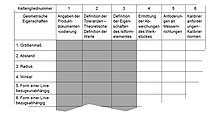GPS matrix
The GPS matrix is based on the ISO / TR 14638: 2015-12 Geometrical Product Specification (GPS) standard. The GPS standards are represented in the GPS matrix model and listed with the important information in the appendix to the GPS standard.
Classification
The matrix is divided into different areas:
The basic standards contain, for example, basic rules such as the principle of independence (ISO 8015), basic rules and procedures for GPS dimensioning (ISO 1101, ISO 286-1). These basic standards take precedence over all other standards.
There are also global GPS standards . These include or influence some or all chains of standards. A typical example is ISO 1 "Establishing the reference temperature". The general GPS standards form a matrix of 20 (or 18) geometric features and the associated standard chains.
A chain of standards consists of seven chain links (numbered from A to G) and is developed as a "general GPS chain of standards" for the geometric and technological properties.
The supplementary GPS standard chains contain z. B. the tolerance standards of some important manufacturing processes (currently A1 to A7), the best known is probably ISO 2768 "General tolerances" for machining processes. Another part covers the area of geometry standards for certain machine elements (currently B1 to B3).
The GPS chain links
- A: Symbols and information (previously chain link 1): Contains the group of standards that regulate the entry of work piece properties on drawings.
- B: Tolerance zones and parameters (formerly chain link 2) contains the group of standards that regulate the tolerance of workpiece properties.
- C: Characteristics of geometry elements (previously chain link 3) contains the group of standards that deals with the definition of the actual geometry element (real workpiece property).
- D: Comparison and Agreement (New) : contains the group of standards which deals with the determination of the deviations and the comparison with the tolerance limits.
- E: Measurement (previously chain link 4) : contains the group of standards that define the requirements for the measuring equipment.
- F: measuring device (formerly chain link 5)
- G: Calibration (formerly chain link 6) : contains the group of standards which define the calibration requirements and the calibration. This is of particular importance for the measurability of geometric properties including traceability and the specification of measurement uncertainties.
See also
Individual evidence
- ↑ ISO-GPS: Matrix model and principles. May 2, 2018, accessed January 11, 2020 .

